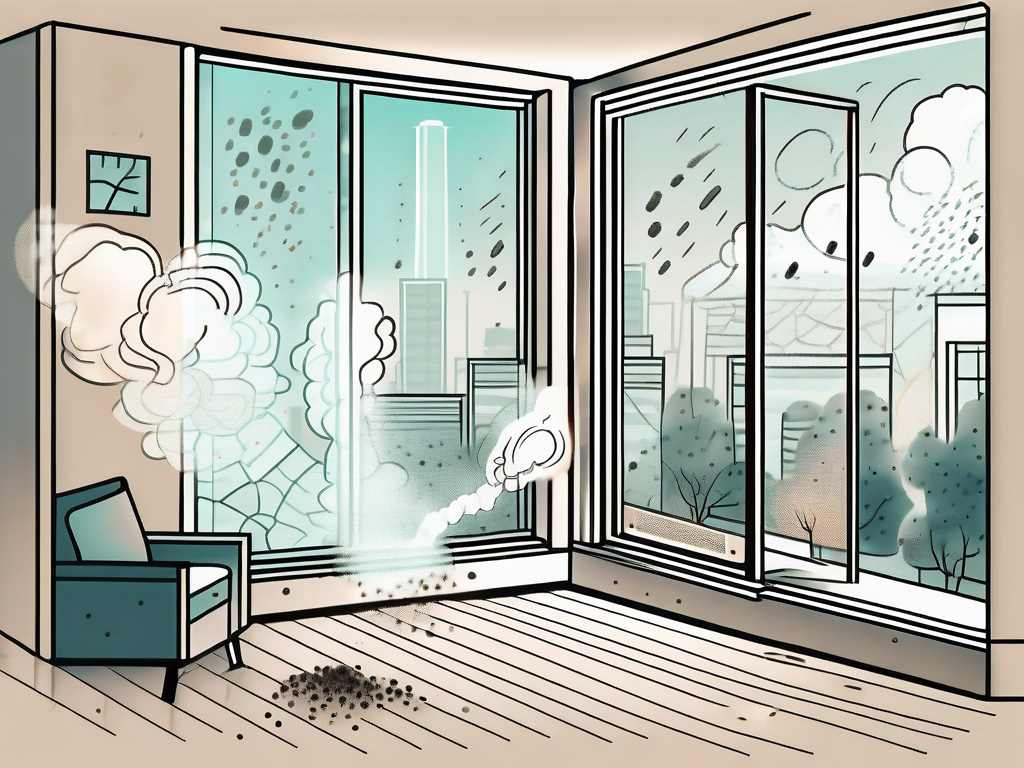Particulate matter, often abbreviated as PM, refers to a complex mixture of extremely small particles and liquid droplets that get suspended in the air. These particles are made up of a number of components, including acids, organic chemicals, metals, soil, and dust particles. The size of these particles can vary, but they are typically characterized as being less than 10 micrometers in diameter. This is about one-fifth the thickness of a human hair, making them invisible to the naked eye.
The quality of indoor air is greatly influenced by the concentration of these particulates. High levels of particulate matter can have detrimental effects on human health and the environment. This article delves into the intricate details of particulate matter, its sources, effects on health and the environment, and ways to control and reduce its levels indoors.
Understanding Particulate Matter
Particulate matter is a term used to describe a wide range of particles that are small enough to be carried by the air and inhaled into the lungs. These particles can be solid or liquid, or a combination of both. They can originate from a variety of sources, both natural and man-made, and can be composed of a wide range of materials.

The size of particulate matter is directly linked to their potential for causing health problems. The Environmental Protection Agency (EPA) groups particulate matter into two categories: PM10 and PM2.5. PM10 refers to particles with diameters that are 10 micrometers and smaller, while PM2.5 refers to particles with diameters that are 2.5 micrometers and smaller. These particles are so small that they can only be detected with an electron microscope.
Composition of Particulate Matter
The composition of particulate matter can vary greatly depending on the source and the environmental conditions. They can be composed of a wide range of materials, including dust, pollen, soot, smoke, and liquid droplets. Some particles are emitted directly from a source, such as construction sites, unpaved roads, fields, smokestacks, or fires. Others form in complicated reactions in the atmosphere of chemicals such as sulfur dioxide and nitrogen oxides, which are emitted from power plants, industries, and automobiles.
Indoor sources of particulate matter can include tobacco smoke, cooking, burning candles or oil lamps, and operating fireplaces and fuel-burning space heaters. Even activities such as walking on a carpet or using certain types of printers can generate particulate matter. Furthermore, outdoor particulate matter can also infiltrate indoors, contributing to the indoor particulate matter levels.
Measurement of Particulate Matter
Particulate matter is typically measured in micrograms per cubic meter (µg/m3). This measurement represents the concentration of particulate matter in the air. The EPA has set National Ambient Air Quality Standards for particulate matter, with separate standards for PM10 and PM2.5. The standards are based on the average annual concentration and the 24-hour concentration of particulate matter in the air.
Indoor particulate matter levels can be measured using a variety of instruments. These include optical particle counters, which use a light source and a detector to count and size particles, and filter-based methods, which draw air through a filter and then weigh the collected particles. Other methods include condensation particle counters and electrical low-pressure impactors.
Effects of Particulate Matter on Health
The health effects of particulate matter are significant. When inhaled, these tiny particles can penetrate deep into the lungs and even enter the bloodstream. This can lead to a range of health problems, from minor irritations to serious conditions.
Short-term exposure to particulate matter can cause irritation of the eyes, nose, and throat, coughing, shortness of breath, and chest pain. It can also exacerbate existing respiratory conditions, such as asthma and chronic obstructive pulmonary disease (COPD). Long-term exposure to particulate matter can lead to more serious health effects, including the development of heart and lung diseases and even premature death.
Impact on Respiratory System
One of the primary health concerns associated with particulate matter is its impact on the respiratory system. When inhaled, these particles can penetrate deep into the lungs, causing inflammation and a worsening of respiratory conditions. This can lead to symptoms such as coughing, wheezing, shortness of breath, and chest tightness.
People with existing respiratory conditions, such as asthma or COPD, are particularly vulnerable to the effects of particulate matter. Exposure to these particles can trigger asthma attacks and exacerbate COPD symptoms. Even in people without pre-existing conditions, long-term exposure to particulate matter can lead to the development of respiratory diseases.
Impact on Cardiovascular System
Particulate matter can also have significant effects on the cardiovascular system. When these particles penetrate deep into the lungs, they can enter the bloodstream. This can lead to inflammation and oxidative stress, which can damage the blood vessels and lead to the development of cardiovascular diseases.
Studies have linked exposure to particulate matter with an increased risk of heart attacks, strokes, and premature death from heart disease. Even short-term exposure to high levels of particulate matter can increase the risk of heart attacks, particularly in people with pre-existing heart conditions.
Effects of Particulate Matter on the Environment
Particulate matter not only affects human health but also has significant impacts on the environment. These particles can affect visibility, damage buildings and monuments, and have harmful effects on ecosystems and wildlife.

When particulate matter settles on the ground or in water bodies, it can change the nutrient balance, acidity, and other characteristics of these environments. This can affect the health and diversity of plants and animals in these ecosystems. In addition, particulate matter can also contribute to climate change by affecting the Earth’s radiation balance.
Impact on Visibility
One of the most noticeable effects of particulate matter on the environment is its impact on visibility. These particles can scatter and absorb light, leading to hazy conditions and reduced visibility. This is particularly noticeable in urban areas and regions with high levels of air pollution.
Reduced visibility due to particulate matter not only affects the aesthetic appeal of landscapes but can also have practical implications. For instance, it can affect air travel and other forms of transportation, and can even increase the risk of accidents due to poor visibility.
Impact on Buildings and Monuments
Particulate matter can also have damaging effects on buildings and monuments. These particles can settle on surfaces and, over time, cause discoloration and erosion. This is particularly a problem for historical monuments and buildings, which can suffer significant damage due to particulate matter pollution.
Moreover, certain types of particulate matter, such as those containing sulfuric acid, can react with the materials in buildings and monuments, leading to chemical changes and further damage. This not only affects the aesthetic appeal of these structures but can also lead to structural damage over time.
Controlling and Reducing Indoor Particulate Matter
Given the significant health and environmental impacts of particulate matter, it is important to take steps to control and reduce its levels indoors. There are a variety of strategies that can be employed, ranging from source control to the use of air cleaners.

Source control is the most effective strategy for reducing indoor particulate matter. This involves identifying and eliminating or reducing the sources of these particles. For instance, avoiding the use of tobacco products indoors, using exhaust fans when cooking, and maintaining fuel-burning appliances can significantly reduce the levels of particulate matter indoors.
Use of Air Cleaners
Air cleaners can also be effective in reducing indoor particulate matter levels. These devices work by drawing air through a filter or other mechanism to remove particles. There are a variety of air cleaners available, ranging from small, portable units to larger, whole-house systems.
When choosing an air cleaner, it is important to consider its efficiency in removing particulate matter, as well as its clean air delivery rate (CADR). The CADR indicates the volume of clean air that an air cleaner produces per minute. It is also important to maintain the air cleaner according to the manufacturer’s instructions to ensure its effectiveness.
Improving Ventilation
Improving ventilation can also help reduce indoor particulate matter levels. This can be achieved by increasing the amount of outdoor air coming indoors, for instance, by opening windows and doors, using window or attic fans, or running a window air conditioner with the vent control open. However, if the outdoor air is polluted, it may be necessary to limit the amount of outdoor air coming indoors.
In addition to these strategies, regular cleaning of the indoor environment can also help reduce particulate matter levels. This can include vacuuming carpets and upholstery, dusting surfaces, and washing bedding regularly.
Conclusion
Particulate matter is a significant contributor to indoor air pollution and can have serious impacts on human health and the environment. Understanding the sources and effects of these particles, as well as strategies for controlling and reducing their levels indoors, is crucial for maintaining good indoor air quality and protecting health and well-being.
While it is not possible to completely eliminate particulate matter from the indoor environment, taking steps to reduce its levels can significantly improve indoor air quality and reduce the risk of health problems associated with exposure to these particles.




